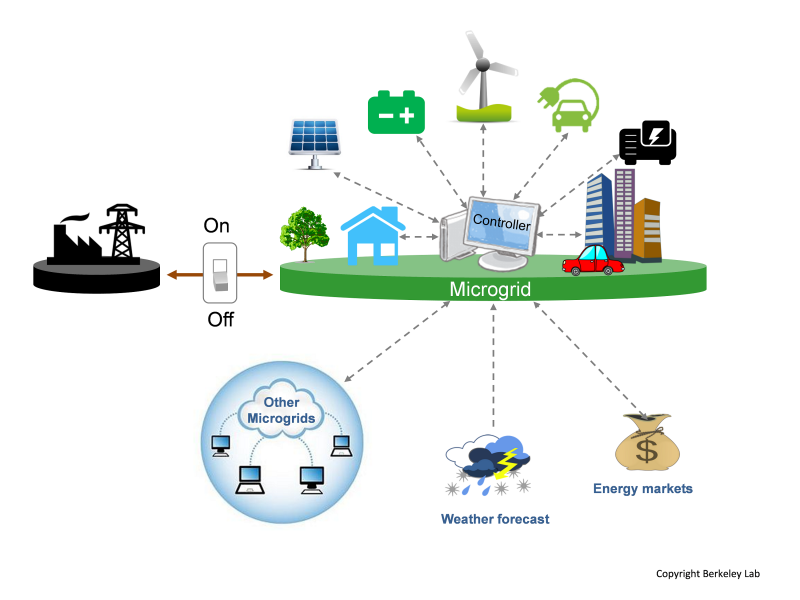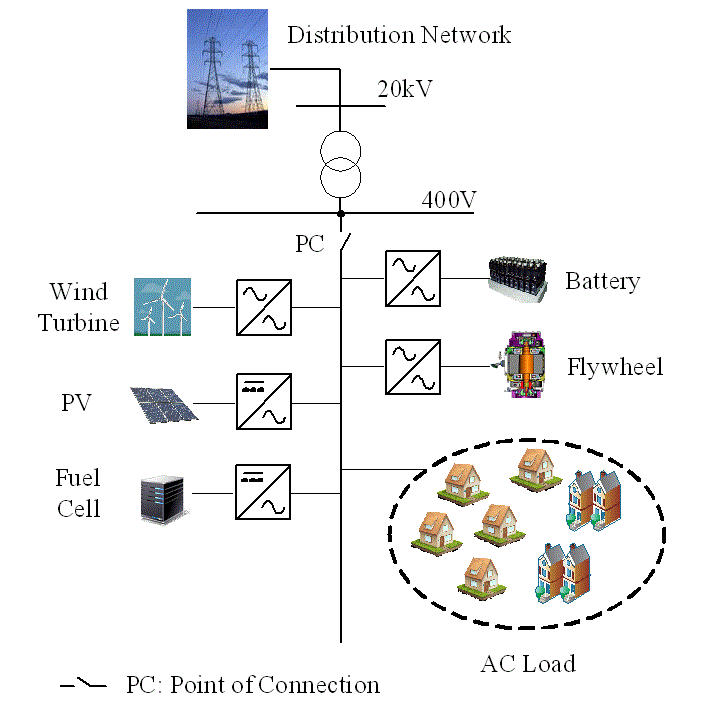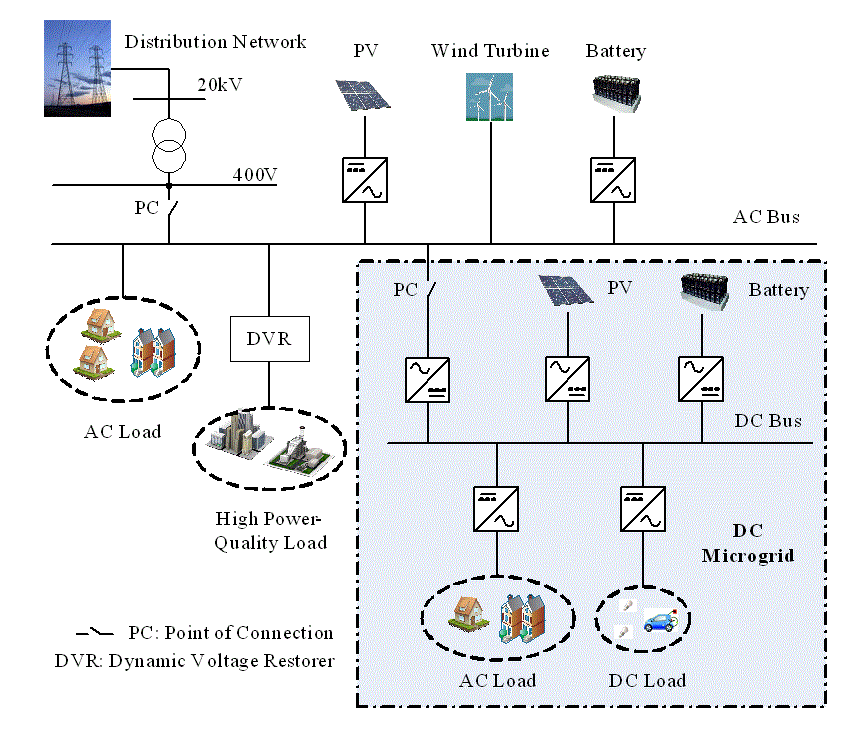A microgrid is a small electricity generation and distribution system containing distributed generation, energy storage systems, loads and monitoring and protection devices.
It is an autonomous system that is self-controlled and self-managed. An energy microgrid provides users thermal energy for heating and cooling in addition to electricity.
A fundamental feature of a microgrid is that it can operate either in grid-connected or islanded mode. In the grid-connected mode, the microgrid exchanges electrical energy with the bulk power grid.
Microgrid Advantages
The advantages of microgrids include the following:
1. The controllable power sources and energy storage systems in a microgrid can accommodate the fluctuations of renewable power generation and thus improve power quality.
Diverse operational objectives such as minimizing operational costs and maximizing energy utilization can be achieved through effective management of distributed generation and loads and the design of energy management systems.
2. A microgrid can provide differentiated custom-made services to satisfy all kinds of loads. For example, a microgrid can supply important loads with high-reliability power, while supplying less important loads with cheaper power at lower reliability.
3. In distribution networks, a microgrid acts as a virtual power source or load. Therefore, peak shaving can be realized through coordinated control of distributed generation and loads.
Moreover, the adverse impacts of a high penetration of distributed generation can be reduced to a great extent by microgrids, thus helping system operators manage the distribution network more easily.
4. Because of the ability of independent operation, microgrids assist distribution networks with self-healing after faults. When there are faults in the network, many microgrids can keep supplying important loads.
5. A microgrid can be constructed and operated by power users, power companies or independent third-party energy companies. This kind of multi-party operation encourages all kinds of stakeholders to participate in the construction of renewable power generation facilities, thus promoting the revolution of the market model and mechanism in the energy field.
Microgrid Structure
AC Microgrid
In an AC microgrid, distributed generators and energy storage systems are connected to an AC bus through power electronics devices, as shown in Figure 1.
Through on/off control at the point of connection (PC), the microgrid can be switched into either grid-connected mode or islanded mode.
Figure 1 Typical structure of an AC microgrid.
DC Microgrid
A DC microgrid has a DC bus to which distributed generators, energy storage systems and loads are connected. The DC network is connected to the bulk AC power grid through a power electronics inverter, as shown in Figure 2.
AC and DC loads at different voltage levels can be supplied by a DC microgrid through power electronic devices. The fluctuation of distributed generation and loads can be regulated by energy storage systems connected to the DC bus.
Figure 2 Typical structure of a DC microgrid.
In a DC microgrid, distributed generators are connected to the DC bus only through a single-stage voltage transformation device. This structure is more economical in cases where there are many DC power sources and loads, such as PV systems and fuel cells.
Hybrid AC–DC Microgrid
The hybrid AC–DC microgrid shown in Figure 3 is composed of an AC and DC bus and supplies both AC and DC loads. It can be considered as a special form of an AC microgrid considering the DC network as a power source that is connected to the AC bus through a power electronic inverter.
A hybrid AC–DC microgrid combines the characteristics of both AC and DC microgrids and can better supply different types of loads.
Figure 3 Typical structure of a hybrid AC–DC microgrid
Microgrid Applications
As a system that provides users with custom power supply services, a microgrid can be applied to various scenarios with different components, structures and operational characteristics, including
1. Independent microgrids on islands or in remote areas: It is difficult and expensive to construct a conventional power grid on islands or in remote areas, so a microgrid can be attractive.
For a microgrid in an island or remote area, the components and structures should be decided based on local environmental conditions. For example, when there are abundant wind and solar resources, the microgrid can be composed of wind turbine generators, PV arrays, diesel generators, and batteries. This kind of microgrid then operates in islanded mode.
Although diesel generators are still needed considering the uncertainty of wind and solar energy, both annual operating hours and diesel consumption are reduced significantly.
2. Renewable energy–dominated microgrid in areas with a high penetration of renewables: In areas with abundant solar/wind energy, problems of overvoltage may occur if large amounts of solar/wind generation are connected to the distribution network directly. Therefore, a renewable energy–dominated microgrid at the user or community level can be built to improve the capability of the power grid to integrate distributed renewable energy.
This kind of microgrid is mainly composed of solar/ wind generation and batteries and usually operates in grid-connected mode. It can also operate in an islanded mode to supply users independently when needed.
Figure 4 Typical structure of a highly integrated microgrid in the distribution network.
3. Integrated energy microgrid in areas with diverse energy sources and demands: When there are abundant energy sources and diverse demands like cooling/heating/electricity demands, an integrated energy microgrid can be constructed to serve large public buildings, schools or hospitals. The main purposes of this kind of microgrid are to integrate building/ community energy-saving technology, improve integrated energy utilization and realize efficient use of energy.
In such microgrids, electrical energy is generated by solar, wind, geothermal or biomass energy and is stored in electrical or thermal energy storage systems. In addition, combined cooling, heating and power is a typical characteristic of such microgrids.
4. Highly integrated microgrid in distribution networks with extensive distributed energy: This kind of microgrid is an important part of smart distribution networks, as shown in Figure 4.
Because distributed generators like PV systems and wind generators that are directly connected to the distribution network cannot supply loads independently, they have to be shut down when there are faults in the distribution work.
By integrating distributed generators into branch-level, feeder-level and substation-level microgrids in distribution networks, distributed generators can supply key loads when there are faults in the bulk power grid during disasters and can improve the self-healing ability of distribution networks.





